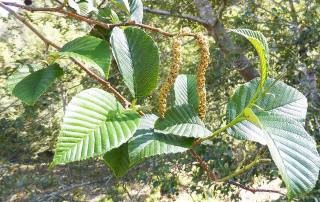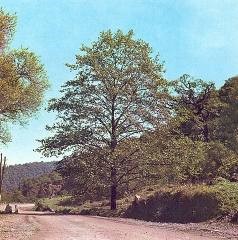Alder
Scientific Name: Alnus acuminata
Climate: Hot, temperate, cold
Plant Description: It is a tree that grows from 1000 to 3800 meters above sea level. It is usually found in large groups near the water. It is a wild plant from tropical forest, oak, pine and mixed pine - oak forests. It is a medium sized tree that grows quickly, reaching a height of 6 to 15 m, but can reach up to 30 m and with trunks of 70 cm wide. It has several trunks that grow upwards. Smooth branches of reddish color. The leaves are oval shaped with a point and are 5-12 cm long. During the dry season, the trees lose their leaves partially or completely. It flowers from February to April.
It is native to the Americas, from Mexico to Argentina, but not in Brazil. It grows in semi-warm and temperate climates.
Cultivation: This tree reproduces through seeds, root or branch cuttings in open areas with wet soil. To reproduce with cuttings, it is best to take young and healthy branch cuttings right before spring. The basal cut should be made just below a knot or an axillary bud. They should be between 7.5 cm and 15 cm. The branches should be pruned of all their leaves only live the adventitious buds. Bury them in loose, rich, well-drained soil at a distance of 3 meters.
Seed reproduction gives deeper roots. To collect the seed, harvest the fruits when the color changes from green to yellow, before opening. It is necessary to leave the fruits for 20-30 days in full sun, until fruit begins to open. Take out the seed and sow it into the seedbed. The seed germinates in full sun between 12 to 30 days after sowing. The strongest sprouts are transplanted into pots or bags after 20 days. From there, they are passed to the soil when they reach 20 cm high (about 4 months).
Prefers semi-shade although tolerates direct sun. It likes sloping, wet soils with good drainage. It tolerates poor quality soils as long as they are kept moist in the early stages. Once it is mature, it adapts to slightly drier conditions.
 Uses: It is used for firewood because it burns evenly. The wood is also used in construction to make posts and plywood. It can even serve as a post for living fences, and windbreaks. Traditionally, it is used to make musical instruments, crafts, even yellow and beige dyes with the bark and yellow and green with the leaves, broomsticks, boxes, matches and charcoal (but fluffy).
Uses: It is used for firewood because it burns evenly. The wood is also used in construction to make posts and plywood. It can even serve as a post for living fences, and windbreaks. Traditionally, it is used to make musical instruments, crafts, even yellow and beige dyes with the bark and yellow and green with the leaves, broomsticks, boxes, matches and charcoal (but fluffy).
The bark has a lot of tannin which is used for leather tanning. It fixes the nitrogen and gives a lot of organic matter to the soil, then it serves to make fertilizer and improve the soil for agriculture. It provides good shade. The flower gives a lot of pollen that feeds the bees in the winter when they struggle to feed from other sources. It is also a source of food for birds. This tree serves well for reforestation. It grows well in sloping soil and serves to hold the soil and prevent erosion from its roots growing outwards and not just downwards.
The leaves and bark have medicinal properties. They help to relieve pain from joints, muscles and rheumatism. They are also used for colds and sore throats. It is used to relieve skin problems. The inner bark boiled in vinegar is used externally against lice and skin scales. It is used to relieve gastritis, vomiting, laryngitis, bleeding, sores and wounds. The bark is astringent both externally and internally and is therefore used to control and prevent bleeding.
The leaves are toxic to livestock.
Pests and Diseases: Alder Leaf Beetle. Clear and dispose of debris from around alders in the fall removes hibernating alder flea beetles that can reproduce later. Spray the trees in the spring with a solution of 5 tablespoons of non-detergent liquid soap per 4 liters of water. Apply the insecticidal soap on both sides of the leaves, and rinse the trees in a few hours to protect them from soap-related sun damage.
Fungal diseases that affect the leaves and foliage; and other fungal diseases that damage the root and stem - to prevent fungal development it is advisable not to water too much. Remove as soon as possible any fallen dead leaf as with time the fungus will grow on top of it and spread to the tree. To treat the fungus: mix 4 liters of water, a tablespoon of dish soap, a tablespoon of baking soda, and if you want a tablespoon of vegetable oil. Spray affected parts including the soil around the tree.
En español: Ilite

